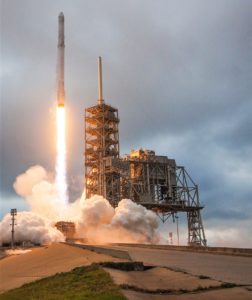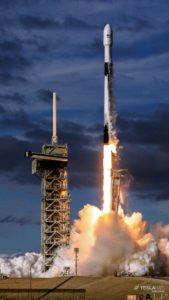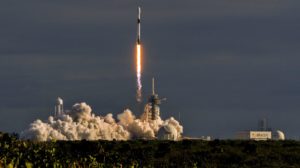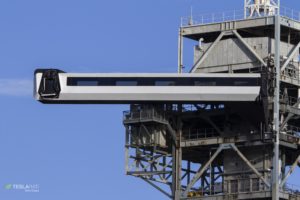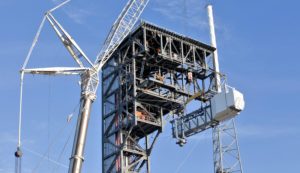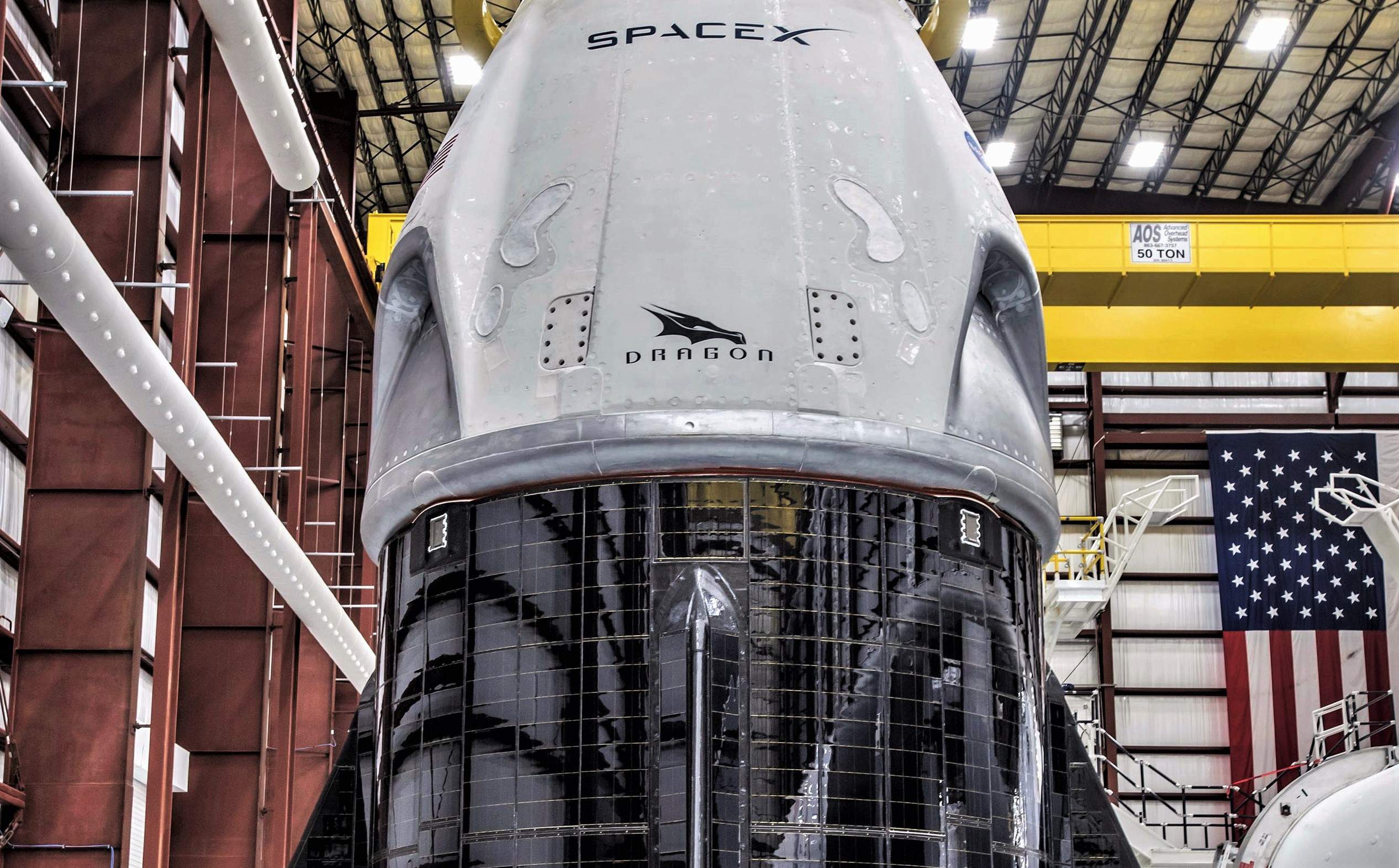

News
SpaceX’s orbit-ready Crew Dragon nears first trip out to Pad 39A atop Falcon 9
Now primarily reserved for launches involving the company’s Falcon Heavy rocket and Crew Dragon spacecraft, SpaceX has begun touching up its Launch Complex 39A (LC-39A) pad with new paint and hardware in anticipation of the first orbital launch of Crew Dragon, set to occur as early as the evening of January 17th.
A little over three weeks away from the milestone mission’s launch, SpaceX has – even more importantly – rolled Pad 39A’s transporter/erector (T/E) into an on-site hangar, where Falcon 9 B1051 and Crew Dragon C201 are awaiting final integration and fit checks prior to a series of careful dress rehearsals including a dry (mission) rehearsal, a wet rehearsal (WDR), and an on-pad static fire.
@NASASpaceflight looks SpaceX is giving the tower at 39A a fresh paint job pic.twitter.com/l6ZD6c6PvN
— Evan Richard (@TheEvangineer) December 21, 2018
Over the past month or two, SpaceX’s Florida pad technicians have gradually begun a number of small but important modifications to Launch Complex 39A (LC-39A, Pad 39A), primarily focused on what is known as its Fixed Service Structure (FSS), a tall and rectangular tower off to the side of SpaceX’s launch mount. Notably, SpaceX has completed the demolition and removal of all extraneous Pad 39A structures related to its decades of service under the Space Shuttle program and has further modified the FSS to allow for the installation of Crew Dragon’s Crew Access Arm (CAA), completed earlier in 2018.
With those major tasks complete, SpaceX workers have since subtly modified the pad’s transporter/erector (T/E) for Crew Dragon and begun to both paint and clad the tower, both designed to minimize wear and tear from regular launch operations and coastal Florida’s omnipresent sea breeze. Captured in photos from the November 2018 launch of Es’hail-2, the tower cladding appears to be made of double-layered sheets of half-opaque black plastic, while the paint of choice is gray (and black accents) to mesh with the tower’s minimalist arm.
Given CEO Elon Musk’s well-known preference that his companies, products, and facilities look “beautiful”, this is almost certainly being done on his whim, albeit for the best. A coat of paint and minimalist arm design are probably cost a minimal amount of money and effort, but the bare minimum still easily sets SpaceX’s facilities apart from competitors like ULA and even NASA.
- A panorama of LC-39A in November 2017. (Tom Cross/Teslarati)
- Pad 39A seen after most extraneous Shuttle-era hardware had been removed, November 2018. (Tom Cross)
- Falcon 9 B1047 lifts off from Pad 39A, November 2018. (Tom Cross)
- A detailed look at SpaceX’s shiny new Crew Access Arm, installed on Pad 39A in August 2018. (Tom Cross)
- Boeing/ULA’s Starliner Crew Access Arm (CAA) was installed at LC-41 in 2015. (NASA)
Crew Dragon closes in on orbital launches
For perhaps the first in the history of NASA’s Commercial Crew Program (CCP), SpaceX revealed earlier this month that all the major hardware components needed for the first orbital launch of Crew Dragon were under one literal roof at the company’s Pad 39A launch complex. In the weeks and months prior, both Musk and COO/President Gwynne Shotwell stated rather explicitly that that hardware would indeed be physically ready to launch no later than the end of 2018, even suggesting that SpaceX engineers and technicians would attempt to conduct a dry (propellant-less) Mission Dress Rehearsal (MDR) to ensure everything fits together in late December.
omfg @spacex just posted some absolutely stunning photos inside Pad 39A's hangar: meet the first completed Crew Dragon and its Falcon 9 Block 5 rocket (B1051) 😀 In the far left (second photo), you can also see what is probably B1047 in the midst of refurbishment. pic.twitter.com/NWULyAEhpQ
— Eric Ralph (@13ericralph31) December 18, 2018
As of last week, 39A’s T/E disappeared from its launch mount, indicating that the pad crew had rolled the massive apparatus into the complex’s integration hangar, where the above Falcon 9(s) and Demo-1 Crew Dragon were stashed as of December 18th. Having spent a solid five days in the hangar, SpaceX technicians have likely begun or even completed the integration of Falcon 9 B1051 and Crew Dragon and proceeded to integrate that full rocket/spacecraft combo to the T/E. As such, the T/E could very well roll out of its hangar with Falcon 9 and Crew Dragon attached at almost any moment between now and 2019.
If all goes as planned and NASA and SpaceX can wrap up paperwork (certification, approvals, etc) in the next week or two, SpaceX could launch an uncrewed Crew Dragon into orbit as early as the evening of January 17th. The rocket’s rollout will be the be the next major milestone so stay tuned!
For prompt updates, on-the-ground perspectives, and unique glimpses of SpaceX’s rocket recovery fleet check out our brand new LaunchPad and LandingZone newsletters!
News
SpaceX’s Crew-11 mission targets July 31 launch amid tight ISS schedule
The flight will lift off from Launch Complex 39A at Kennedy Space Center in Florida.

NASA and SpaceX are targeting July 31 for the launch of Crew-11, the next crewed mission to the International Space Station (ISS). The flight will lift off from Launch Complex 39A at Kennedy Space Center in Florida, using the Crew Dragon Endeavour and a Falcon 9 booster.
Crew Dragon Endeavour returns
Crew-11 will be the sixth flight for Endeavour, making it SpaceX’s most experienced crew vehicle to date. According to SpaceX’s director of Dragon mission management, Sarah Walker, Endeavour has already carried 18 astronauts representing eight countries since its first mission with NASA’s Bob Behnken and Doug Hurley in 2020, as noted in an MSN report.
“This Dragon spacecraft has successfully flown 18 crew members representing eight countries to space already, starting with (NASA astronauts) Bob (Behnken) and Doug (Hurley) in 2020, when it returned human spaceflight capabilities to the United States for the first time since the shuttle retired in July of 2011,” Walker said.
For this mission, Endeavour will debut SpaceX’s upgraded drogue 3.1 parachutes, designed to further enhance reentry safety. The parachutes are part of SpaceX’s ongoing improvements to its human-rated spacecraft, and Crew-11 will serve as their first operational test.
The Falcon 9 booster supporting this launch is core B1094, which has launched in two previous Starlink missions, as well as the private Ax-4 mission on June 25, as noted in a Space.com report.
The four-members of Crew-11 are NASA astronauts Zena Cardman and Mike Fincke, as well as Japan’s Kimiya Yui and Russia’s Oleg Platonov.
Tight launch timing
Crew-11 is slated to arrive at the ISS just as NASA coordinates a sequence of missions, including the departure of Crew-10 and the arrival of SpaceX’s CRS-33 mission. NASA’s Bill Spetch emphasized the need for careful planning amid limited launch resources, noting the importance of maintaining station altitude and resupply cadence.
“Providing multiple methods for us to maintain the station altitude is critically important as we continue to operate and get the most use out of our limited launch resources that we do have. We’re really looking forward to demonstrating that capability with (CRS-33) showing up after we get through the Crew-11 and Crew-10 handover,” Spetch stated.
Lifestyle
EV fans urge Tesla to acquire Unplugged Performance for edge in fleet and security industry
Unplugged Performance has built a name for itself by producing performance upgrades for Tesla vehicles.

A growing number of Tesla enthusiasts and longtime community voices are calling on the electric vehicle maker to acquire Unplugged Performance, a California-based aftermarket company best known for tuning Tesla vehicles and developing specialized government fleet solutions under its UP.FIT division.
The idea was once considered a niche proposal among EV fans, but it is now gaining serious attention not just as a performance play but as a strategic move to deepen Tesla’s roots in the fleet and security industry.
A strategic fit
Unplugged Performance has built a name for itself by producing performance upgrades for Tesla vehicles, from track-optimized components to visual and aerodynamic upgrades. But in recent years, its UP.FIT division has pivoted toward a more functional future by outfitting Tesla vehicles like Model Ys for police, military, and government use.
That work has sparked growing calls for closer collaboration with Tesla, especially as the EV maker increasingly leans into autonomy, AI, and fleet services as core components of its next chapter.
“I posted this four years ago, but I think it’s more true now than ever,” wrote Whole Mars Catalog, a well-known Tesla investor and FSD Beta tester, on X. “Tesla should buy Unplugged. But not just as a Performance division. What they are doing with UP.FIT unlocks large government and commercial fleet purchases that can improve utilization.”
Tesla fans such as shareholder Sawyer Merritt echoed the sentiment, calling Unplugged a “great fit within Tesla.” adding, “They are literally located directly next to Tesla’s design studio in Hawthorne.”
Enabling the next wave
Supporters of the idea noted that integrating Unplugged into Tesla’s corporate structure could help accelerate the adoption of autonomous technologies in government sectors. With UP.FIT patrol cars already in use across some U.S. police departments, Tesla fans envisioned a future where self-driving Teslas could potentially revolutionize law enforcement, search-and-rescue, and public service logistics.
“Just imagine how autonomous patrol cars could transform policing and bring us into a safer future,” the veteran FSD tester wrote.
The benefits could also extend to Tesla’s existing consumer base. “They also have some incredible products in the works that I think will appeal to many ordinary Tesla drivers — not just those looking for performance or mods. Stuff that’s so good it should have come straight from the design studio next door,” Whole Mars Catalog noted.
Unplugged Performance, founded in 2013, shares not just a product vision with Tesla, but also geography. Its Hawthorne headquarters sits directly adjacent to Tesla’s design studio, and the two companies have maintained a close working relationship over the years. The aftermarket firm has long positioned itself as a “mission-aligned” partner to Tesla.
In response to the recent calls for acquisition, Unplugged Performance acknowledged the support from the community. “Our very existence is to support the Tesla mission with @UpfitTesla and @UnpluggedTesla,” Unplugged CEO Ben Schaffer posted on X. “We love working with Tesla and are grateful for the community’s support since 2013!”
News
Tesla debuts hands-free Grok AI with update 2025.26: What you need to know
All new Tesla vehicles delivered on or after July 12, 2025, will include Grok AI out of the box

Tesla has begun rolling out Grok, an in-car conversational AI assistant developed by xAI, to eligible vehicles starting July 12. The feature marks the most direct integration yet between Elon Musk’s artificial intelligence startup and Tesla’s consumer product lineup, offering drivers hands-free access to a chat-style companion while on the road.
Grok comes pre-installed on new vehicles
According to Tesla’s FAQ page for the feature, all new vehicles delivered on or after July 12, 2025, will include Grok AI out of the box. Owners of older vehicles may gain access through an over-the-air update, provided their vehicle meets a few hardware and software requirements.
Specifically, Grok is currently only supported on Tesla models equipped with an AMD infotainment processor and running vehicle software version 2025.26 and higher. Compatible models include the Model S, Model 3, Model X, Model Y, and Cybertruck. A Premium Connectivity subscription or active Wi-Fi connection is also required.
Tesla notes that additional vehicle compatibility may arrive in future software updates.
Grok’s features and limitations for now
Drivers can engage with Grok using the App Launcher or by pressing and holding the voice command button on the steering wheel. Grok is designed to answer questions and hold conversations using natural language, offering responses tailored to its chosen personality—ranging from “Storyteller” to the more eccentric “Unhinged.”
For fun, Tesla posted a demonstration of Grok likely running on “Unhinged” talking about what it would do to Optimus when they are on a date, much to the shock of the humanoid robot’s official social media account.
It should be noted, however, that Grok cannot currently issue commands to the vehicle itself, at least for now. Traditional voice commands for tasks like climate control, navigation, or media remain separate from Grok as of writing.
The feature is being released in Beta and does not require a Grok account or xAI subscription to activate, although that policy may change over time.
Grok privacy and in-car experience
Tesla emphasizes that interactions with Grok are securely processed by xAI and not linked to a user’s Tesla account or vehicle. Conversations remain anonymous unless a user signs into Grok separately to sync their history across devices.
Tesla has also begun promoting Grok directly on its official vehicle webpages, showcasing the feature as part of its in-car experience, further highlighting the company’s increasing focus on AI and infotainment features on its all-electric vehicles.
-

 Elon Musk2 weeks ago
Elon Musk2 weeks agoTesla investors will be shocked by Jim Cramer’s latest assessment
-

 Elon Musk3 days ago
Elon Musk3 days agoxAI launches Grok 4 with new $300/month SuperGrok Heavy subscription
-

 Elon Musk5 days ago
Elon Musk5 days agoElon Musk confirms Grok 4 launch on July 9 with livestream event
-

 News1 week ago
News1 week agoTesla Model 3 ranks as the safest new car in Europe for 2025, per Euro NCAP tests
-

 Elon Musk1 week ago
Elon Musk1 week agoxAI’s Memphis data center receives air permit despite community criticism
-

 News2 weeks ago
News2 weeks agoXiaomi CEO congratulates Tesla on first FSD delivery: “We have to continue learning!”
-

 News2 weeks ago
News2 weeks agoTesla sees explosive sales growth in UK, Spain, and Netherlands in June
-

 Elon Musk2 weeks ago
Elon Musk2 weeks agoTesla scrambles after Musk sidekick exit, CEO takes over sales


